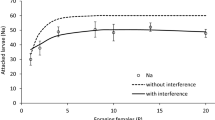Summary
Females of the solitary endoparasitic wasp Biosteres longicaudatus sometimes deposit >1 egg (superparasitism) in each larva of the Caribbean fruit fly host, Anastrepha suspensa. As host density increases, there is an inverse relationship between the level of superparasitism and the number of progeny produced/female. Larval parasitoid competition in superparasitized hosts causes an abrupt decline from >1 to 1 or <1 parasitoid/host 24–36 h before the surviving parasitoid larva molts to the 2nd instar. The mechanism by which supernumaries are eliminated was investigated by indirect, in vivo and direct, in vitro methods. There is no apparent competition between parasitoid eggs of the same age. Parasitoid first instars utilize their heavily sclerotized mandibles to eliminate competitors, some of which are subsequently encapsulated by the host. First instars in vitro produce a substance that kills conspecifics. Presumably, this substance is secreted into the surrounding medium. One of each pair of parasitoid first instars, evenly matched for age and size, may live up to 6.4 days longer and grow to 0.13 mm larger than the other. Thus, B. longicaudatus, like other solitary endoparasitoids eliminates competitors by both combat and interference competitions. The latter case, presumably involves allelochemical toxins against conspecifics in the absence of physical encounter.
Similar content being viewed by others
References
Bakker K, Bagchee SN, van Zwet WR, Meelis W (1967) Host discrimination in Pseudocoila bochei (Hymenoptera: Cynipidae). Entomol Exp Appl 10:295–311
Cals-Usciati J (1982) Les strategies alimentaires de la larve primaire dominante du parasitoide Opius concolor (Hymenoptère, Braconidae) et les mechanismes d'attaque des tissues de l'hôte, Ceratitis capitata (Diptère, Trypetidae). CR Acad Sci Paris 294:379–384
Chow FJ, Mackauer M (1986) Host discrimination and larval competition in the aphid parasite Ephedrus californicus. Entomol Exp Appl 41:243–254
Edson K, Stoltz DB, Summers MD (1981) Virus in a parasitoid wasp: suppression of the cellular immune response in the parasitoid's host. Science 211:582–583
Fisher RC (1961) A study of insect multiparasitism, II. The mechanism and control of competition for posession of the host. J Exp Biol 38:605–628
Fisher RC (1971) Aspects of the physiology of endoparasitic Hymenoptera. Biol Rev 46:243–278
Fisher RC, Ganesalingam VK (1970) Changes in the composition of host hemolymph after attack by an insect parasitoid. Nature 227:191–192
Fuhrer E, Willers D (1986) The anal secretion of the endoparasitic larva Pimpla turionellae sites of production and effects. J Insect Physiol 32:361–367
Hofsvang T, Hagvar EB (1983) Superparasitism and host discrimination by Ephedrus cerasicola (Hym: Aphidiidae), and aphidiid parasitoid of Myzus persicae (Hom: Aphididae). Entomophaga 28:379–386
Lawrence PO (1979) Immature stages of the Caribbean fruit fly, Anastrepha suspensa. Fl Entomol 62:214–219
Lawrence PO, Baranowski RM, Greany PD (1976) Effect of host age on development of Biosteres (Opius) longicaudatus, a parasitoid of the Caribbean fruit fly, Anastrepha suspensa. Fl Entomol 59:33–39
Lawrence PO, Greany PD, Baranowski RM (1978) Oviposition behavior of Biosteres longicaudatus, a parasite of the Caribbean fruit fly, Anastrepha suspensa. Ann Entomol Soc Am 71:253–256
Lawrence PO, Hagedorn HH, Wheelock G (1984) Ecdysteroid levels and integument changes in post-embryonic stages of Anastrepha suspensa. J Insect Physiol 30:713–719
Lenteren JC van (1981) Host discrimination by parasitoids. In: Nordlund DA, Jones RL, Lewis WJ (eds) Semiochemicals: their role in pest control. Wiley and Sons, New York, pp 153–179
Salt G (1936) Experimental studies in insect parasitism. IV. The effect of superparasitism on populations of Trichogramma evanescens. J Exp Biol 13:363–375
Salt G (1961) Competition among insect parasitoids. Symp Soc Exp Biol 15:96–119
Stoltz DB, Vinson SB, Mackinnon EA (1975) Baculovirus-like particles in the reproductive tracts of female parasitoid wasps. Can J Microbiol 22:1013–1023
Wigglesworth VB (1953) Principles of insect physiology, 5th ed. Metheun, London
Wilson DD, Ridgway RL, Vinson SB (1974) Host acceptance and oviposition behavior of the parasitoid Campoletis sonorensis (Hymenoptera: Ichneumonidae). Ann Entomol Soc Am 67:271–274
Wylie HG (1971) Observations on intraspecific larval competition in three hymenopterous parasites of fly puparia. Can Entomol 103:137–142
Wylie HG (1983) Delayed development of Microctonus vittatae (Hymenoptera: Braconidae) in superparasitized adults of Phyllotreta cruciferae (Coleoptera: Chrysomelidae). Can Entomol 115:441–442
Author information
Authors and Affiliations
Rights and permissions
About this article
Cite this article
Lawrence, P.O. Intraspecific competition among first instars of the parasitic wasp Biosteres longicaudatus . Oecologia 74, 607–611 (1988). https://doi.org/10.1007/BF00380060
Received:
Issue Date:
DOI: https://doi.org/10.1007/BF00380060




